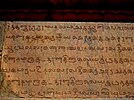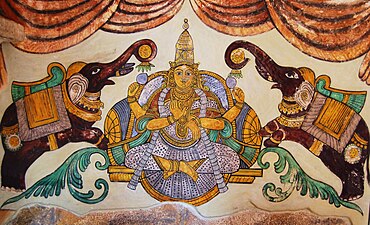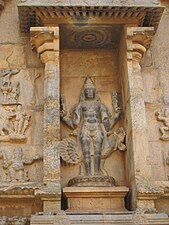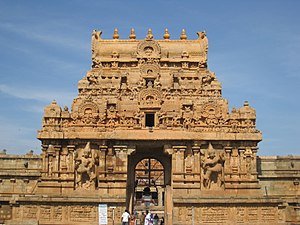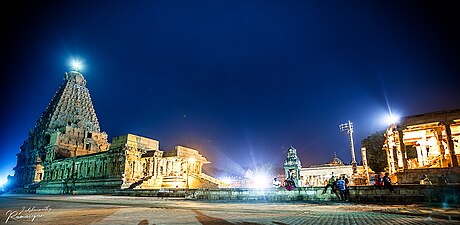
The Kailasanathar Temple, Kanchipuram, also referred to as the Kailasanatha temple, is a Pallava-era historic Hindu temple in Kanchipuram, Tamil Nadu, India. Dedicated to Shiva, it is one of the oldest surviving monuments in Kanchipuram. It reflects a Dravidian architecture and was built about 700 CE by Narasimhavarman II with additions by Mahendravarman III. A square-plan temple, it has a mukha-mandapa, a maha-mandapa and a primary garbha-griya (sanctum) topped with a four-storey vimana. The main sanctum is surrounded by nine shrines, seven outside and two inside flanking the entrance of the sanctum, all with forms of Shiva. The outer walls of the temple's prakara (courtyard) is also surrounded by cells.

The Great Living Chola Temples is a UNESCO World Heritage Site designation for a group of Chola dynasty era Hindu temples in the Indian state of Tamil Nadu. The temple at Thanjavur was added in the list in 1987, while the other two temples were added in 2004.

The period of the imperial Cholas in South India was an age of continuous improvement and refinement of Chola art and architecture. They utilised the wealth earned through their extensive conquests in building long-lasting stone temples and exquisite bronze sculptures, in an almost exclusively Hindu cultural setting.

Thillai Nataraja Temple, also referred as the Chidambaram Nataraja Temple, is a Hindu temple dedicated to Nataraja, the form of Shiva as the lord of dance. This temple is located in Chidambaram, Tamil Nadu, India. This temple has ancient roots and a Shiva shrine existed at the site when the town was known as Thillai. Chidambaram, the name of the city literally means "stage of consciousness". The temple architecture symbolizes the connection between the arts and spirituality, creative activity and the divine. The temple wall carvings display all the 108 karanas from the Natya Shastra by Bharata Muni, and these postures form a foundation of Bharatanatyam, an Indian classical dance.

Dravidian architecture, or the Southern Indian temple style, is an architectural idiom in Hindu temple architecture that emerged from Southern India, reaching its final form by the sixteenth century.

Vimana is the structure over the garbhagriha or inner sanctum in the Hindu temples of South India and Odisha in East India. In typical temples of Odisha using the Kalinga style of architecture, the vimana is the tallest structure of the temple, as it is in the shikhara towers of temples in West and North India. By contrast, in large South Indian temples, it is typically smaller than the great gatehouses or gopuram, which are the most immediately striking architectural elements in a temple complex. A vimana is usually shaped as a pyramid, consisting of several stories or tala. Vimana are divided in two groups: jati vimanas that have up to four tala and mukhya vimana that have five tala and more.

Airavatesvara Temple is a Hindu temple of Dravidian architecture located in Kumbakonam, Thanjavur District in the South Indian state of Tamil Nadu. This temple, built by Chola emperor Rajaraja II in the 12th century CE is a UNESCO World Heritage Site, along with the Brihadeeswara Temple at Thanjavur, the Gangaikondacholisvaram Temple at Gangaikonda Cholapuram that are referred to as the Great Living Chola Temples.

Thenupuriswarar Temple is a Hindu temple dedicated to the god Shiva located in the village of Patteeswaram, Tamil Nadu, India. Shiva is worshiped as Thenupuriswarar, and is represented by the lingam. His consort Parvati is depicted as Nyanambikai (Somakamalambigai). The presiding deity is revered in the 7th century Tamil Saiva canonical work, the Tevaram, written by Tamil saint poets known as the Nayanars and classified as Paadal Petra Sthalam. The temple is associated with the legend of Sambandar to whose view Nandi moved to have a direct view of the presiding deity. Muthupandal festival celebrated in the temple in associated with the legend.

Thyagaraja Temple is a Shiva temple, located in the town of Thiruvarur in Tamil Nadu state, India. Shiva is worshiped in the form of a lingam as Thyagarajaswami, also known as Putridankondar. His consort Parvati is worshipped as Goddess Neelotpalambika. She is also worshipped as Goddess Kamalambika, whose separate shrine is an important center for Shaktism and Tantra, and is also regarded to be one of the Shakti Peethas. The presiding deity is revered in the 7th century Shaiva canonical work, the Tevaram, written in Tamil by saint poets known as the Nayanars and the shrine is classified as a Paadal Petra Sthalam.
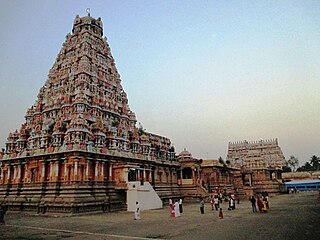
The Kampaheswarar Temple or kampa-hara-ishvarar is a Hindu temple dedicated to the god Shiva. It is situated in Thirubuvanam, a village in Thanjavur district in the South Indian State of Tamil Nadu, on the Mayiladuthurai-Kumbakonam road. Shiva is worshiped as "Kampahareswarar" as he removed the quaking of a king who was being haunted by a Brahmarakshasa. It was built by Kulothunga Chola III and is considered the last of the four masterpieces built during the Medieval Chola era.

Aiyarappar is a Hindu temple dedicated to Shiva located in the village of Tiruvaiyaru, Tamil Nadu, India. Shiva is worshiped as Aiyarappar, and is represented by the lingam and his consort Parvati is depicted as AramValarthaNaayagi. The presiding deity is revered in the 7th century Tamil Saiva canonical work, the Tevaram, written by Tamil poet saints known as the nayanars and classified as Paadal Petra Sthalam.
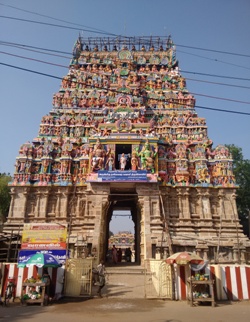
Nageswaraswamy Temple is a Hindu temple dedicated to Shiva located in Kumbakonam in Thanjavur district, Tamil Nadu, India. The presiding deity is revered in the 7th-century Tamil Saiva canonical work, the Tevaram, written by Tamil poet saints known as the nayanars and classified as Paadal Petra Sthalam. The temple is counted as the earliest of all Chola temples. Shiva in the guise of Nagaraja, the serpent king..

Sivayoginathar Temple also known as Yoganandeswarar temple is a Hindu temple dedicated to Shiva located in is located in Thiruvisanallur in Thanjavur district, Tamil Nadu, India. Shiva is worshiped as Sivayoginathar, and is represented by the lingam and his consort Parvati is depicted as Mangala Nayagi. The presiding deity is revered in the 7th century Tamil Saiva canonical work, the Tevaram, written by Tamil poet saints known as the nayanars and classified as Paadal Petra Sthalam.
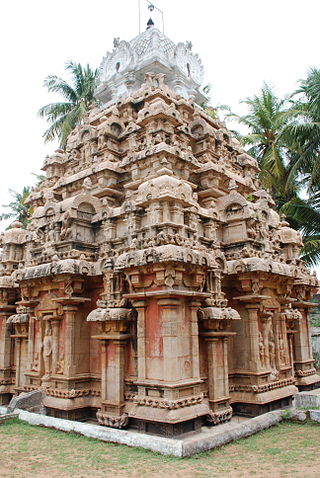
Tirupullamangai or Thirupullamangai is a Hindu temple dedicated to Lord Siva located in Pasupathikoil, Papanasam taluk of Thanjavur district, Tamil Nadu, India. It is one of the shrines of the 275 Paadal Petra Sthalams - Shiva Sthalams glorified in the early medieval Tevaram poems by Tamil Saivite Nayanar Tirugnanasambandar.

Pushpavananathar Temple is a Hindu temple dedicated to Shiva located in the village of Tiruppoonturutti near Tiruvaiyaru, Tamil Nadu, India. Shiva is worshiped as Aiyarappar, and is represented by the lingam and his consort Parvati is depicted as Soundaranayagi. The presiding deity is revered in the 7th century Tamil Saiva canonical work, the Tevaram, written by Tamil poet saints known as the nayanars and classified as Paadal Petra Sthalam.
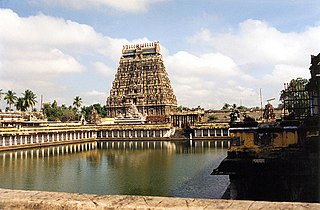
Iconography of Shiva temples in Tamil Nadu is governed by the Shaiva Agamas (IAST:Āgama) that revere the ultimate reality as the Hindu deity, Shiva. Āgama in the Hindu religious context means a traditional doctrine or system which commands faith. Temple worship according to Āgamic rules can be said to have started during the Pallava dynasty in South India, but they were fully under establishment during the Chola dynasty The temples during the Chola period expanded to Sri Lanka and islands in South East Asia. The temple complex was expanding with niches for various deities on the stipulated sides of the sanctum. Lingam was universalised and prakarams (precincts) with subsequent deities came up. The temple parivara expanded considerably during the Chola period. The niches of following Āgamic rules for building Shiva temples in Tamil Nadu, a South Indian state continues even in the modern era. Some of the prime images like that of lingam, Vinayagar and Parvati are present in all the Shiva temples. Almost all the temples follow the same custom during festivals and worship methods with minor exceptions. Most of the Shiva temples in Tamil Nadu and Sri Lanka are built in Dravidian architecture.
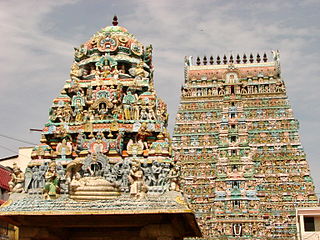
Tamil Nadu is known for its ancient temple architecture. Nearly 33,000 ancient temples, many at least 800 to 2000 years old, are found scattered all over Tamil Nadu. As per Tamil Nadu Hindu Endowments Board, there are 38,615 temples. Most of the largest Hindu Temples reside here. Studded with complex architecture, a variety of sculptures, and rich inscriptions, the temples remain the very essence of the culture and heritage of Tamil land, with historical records dating back to at least 3,000 years.

The Brihadisvara Temple is a Hindu temple dedicated to Shiva in Gangaikonda Cholapuram, Jayankondam, in the South Indian state of Tamil Nadu. Completed in 1035 AD by Rajendra Chola I as a part of his new capital, this Chola dynasty era temple is similar in design, and has a similar name, as the older 11th century, Brihadeeswarar Temple about 70 kilometres (43 mi) to the southwest in Thanjavur. The Gangaikonda Cholapuram Temple is smaller yet more refined than the Thanjavur Temple. Both are among the largest Shiva temples in South India and examples of Dravidian style temples. The temple is also referred to in texts as Gangaikonda Cholapuram Temple or Gangaikondacholeeswaram Temple

Kapardeeswarar temple is a Hindu temple situated in the village of Thiruvalanchuzhi near Swamimalai in Kumbakonam taluk of Thanjavur district, Tamil Nadu, India. Shiva is worshiped as Kapardeeswarar and is represented by the lingam and his consort Parvati is depicted as Brihannayagi. The presiding deity is revered in the 7th century Tamil Saiva canonical work, the Tevaram, written by Tamil poet saints known as the nayanars and classified as Paadal Petra Sthalam.





















